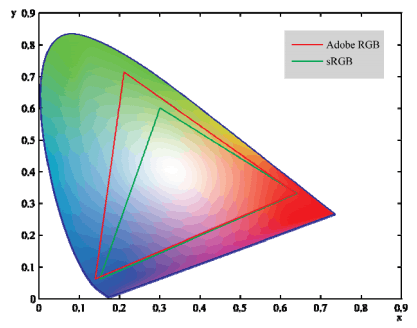I think the biggest factor in this is not the high fidelity output, but the possibility to more accurately match a given target color.
Especially when working in print, you want to take care that what you're seeing on screen matches the printed result to a tee. That is much harder if you only have a small amount of colors to chose from. If you have a billion colors, it's much easier to produce a match.
The Need for 10-bit Displays
Conventional display devices use 8-bits per color channel (or 24-bits per pixel) to display images and video. Although this amounts to more than 16 million colors, it still corresponds to a fraction of the colors we perceive in the real-world. This is illustrated in Figure 1, where the green triangle shows the boundaries of the sRGB color space on the CIE-xy chromaticity diagram.

Conventional sRGB compliant 8-bits monitors can only represent the colors that lie in this triangle, while the human eye is capable of perceiving all the colors in the entire chromaticity diagram. This discrepancy is further emphasized by the fact that today’s most professional cameras and printers have a color gamut larger than that of sRGB (such as Adobe RGB shown by the red triangle in Figure 1), creating a bottleneck on the display side.
HP also brings up what they call "banding", an effect that can be seen when very similar colors are displayed close together and become too distinguishable from each other.
The Benefits of 30-bit
It might seem that a 24-bit panel, which offers 16.7 million colors, would be sufficient. For most
purposes, that’s true. However, there are cases where 8-bits per sub-pixel is not enough.
Consider a grayscale image. Gray (including white and black) is produced when the three sub-pixels (red, green, and blue) are equally bright. This means that the values for the three sub-pixels are the same: 35/35/35, for example. With 8-bits per sub-pixel, gray can go from 0/0/0 (black) to
255/255/255 (white). Therefore, there are only 256 levels of gray possible.
This can lead to "banding", which is an effect that arises because the step between adjacent levels of gray is big enough for the eye to detect. It can be a problem in certain kinds of visualization, such as 3D Understanding the HP DreamColor LP2480zx’s 30-bit Panel 2 Gray banding (left, exaggerated) is eliminated by the 30-bit panel (right) rendering for automotive styling. With a 30-bit panel, there are 1024 levels of gray, and it’s almost impossible for the eye to detect the step between adjacent levels.
Input
Additional Information
Photoshop can manipulate and display images that use more than 8 bits per color channel. That does not imply direct support for 10 bit per color channel displays.
That was at least the case in 2010.

Recent 2016+ 27" iMacs support 10-bit color (aka "deep color") throughout, from the GPU to the OS to the screen. All Apple devices as of 2017 also support "wide color", specifically a variant of the DCI-P3 gamut. Source: iMac specs page
– STO – 2017-11-24T02:41:02.5134I tried to reword your question a little so it wouldn't fall under the not constructive clause. I think it's an interesting question about niche hardware, so let's see if there are some experts who can share their experience here. – slhck – 2013-02-02T16:02:32.187